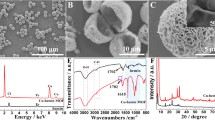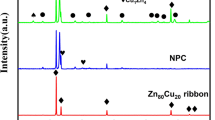Abstract
This work proposed a novel and facile in situ precipitation procedure for synthesis of CuO nanoparticles decorated hierarchical Ce-metal-organic framework nanocomposite (CuONPs/Ce-MOF). The Ce-MOF and CuONPs/Ce-MOF was characterized using electron microscopies, X-ray diffraction, X-ray photoelectron spectroscopy, and thermogravimetry analysis, which showed CuONPs uniformly on straw-sheaf-shaped Ce-MOF surface. In 0.1 M NaOH, CuONPs/Ce-MOF modified electrode showed excellent electrocatalytic activity to glucose oxidation, and the modified electrode was employed to construct a non-enzymatic glucose sensor. The proposed sensor displayed a wide linear range of 5 nM–8.6 mM spanned 6 orders of magnitude, an untrasensitivity of 2058.5 μA mM−1 cm−2, and a low detection limit of 2 nM (S/N = 3). In addition, this sensor displayed excellent repeatability, reproducibility, stability, and selectivity, and the results of glucose detection in human blood serum were very accurate. All these results indicated that CuONPs/Ce-MOF-modified electrode was a promising candidate for practical non-enzymatic sensing for glucose.











Similar content being viewed by others
References
Hossain P, Kawar B, El Nahas M (2007) Obesity and diabetes in the developing world—a growing challenge. N Engl J Med 356:213–215
Dong QC, Huang YK, Song DH (2018) Dual functional rhodium oxide nanocorals enabled sensor for both non-enzymatic glucose and solid-state pH sensing. Biosens Bioelectron 112:136–142
Wang J (2008) Electrochemical glucose biosensors. Chem Rev 108:814–825
Chen C, Xie QJ, Yang DW, Xiao HL, Fu YC, Tan YM, Yao SZ (2013) Recent advances in electrochemical glucose biosensors: a review. RSC Adv 3:4473–4492
Zhang J, Ji YX, Dong HF, Wang WC, Chen ZD (2016) Electrochemical determination of glucose using a platinum-palladium nanoparticle carbonnanofiber glassy carbon electrode. Anal Lett 49:2741–2754
Wilson R, Turner APF (1992) Glucose oxidase—An ideal enzyme. Biosens Bioelectron 7:165–185
Zheng SS, Li B, Tang YJ, Li Q, Xue HG, Pang H (2018) Ultrathin nanosheet-assembled [Ni3(OH)2(PTA)2(H2O)4]·2H2O hierarchical flowers for high-performance electrocatalysis of glucose oxidation reactions. Nanoscale 10:13270–13276
Wu KL, Jiang BB, Cai YM, Wei XW, Li XZ, Cheong WC (2017) Efficient electrocatalyst for glucose and ethanol based on cu/Ni/N-doped graphene hybrids. ChemElectroChem 4:1419–1428
Li XR, Wei JL, Li Q, Zheng SS, Xu YX, Du P, Chen CY, Zhao JY, Xue HG, Xu Q, Pang H (2018) Nitrogen-doped cobalt oxide nanostructures derived from cobalt–alanine complexes for high-performance oxygen evolution reactions. Adv Funct Mater 28:1800886: 1–1800886: 7
Unmuessig T, Weltin A, Urban S, Daubinger P, Urban GA, Kieninger J (2018) Non-enzymatic glucose sensing based on hierarchical platinum micro−/nanostructures. J Electroanal Chem 816:215–222
Le TH, Linh NTY, Chung JS, Hur SH (2017) Green synthesis of silver nanoparticle-decorated porous reduced graphene oxide for antibacterial non-enzymatic glucose sensors. Ionics 23:1525–1532
Baghayeri M, Amiri A, Motamedifar A (2017) Investigation about electrocatalytic oxidation of glucose on loaded ag nanoparticles on functionalized carbon nanotubes. Ionics 22:1709–1717
Zhong SL, Zhuang JY, Yang DP, Tang DP (2017) Eggshell membrane-templated synthesis of 3D hierarchical porous au networks for electrochemical nonenzymatic glucose sensor. Biosens Bioelectron 96:26–32
Yuan M, Liu AP, Zhao M, Dong WJ, Zhao TY, Wang JJ, Tang WH (2014) Bimetallic PdCu nanoparticle decorated three-dimensional grapheme hydrogel for non-enzymatic amperometric glucose sensor. Sensors Actuators B Chem 190:707–714
Shen CC, Su J, Li XZ, Luo JJ, Yang MH (2015) Electrochemical sensing platform based on Pd-au bimetallic cluster for non-enzymatic detection of glucose. Sensors Actuators B Chem 209:695–700
Dolinska J, Kannan P, Sobczak JW, Opallo M (2015) Glucose electrooxidation in bimetallic suspensions of nanoparticles in alkaline media. ChemElectroChem 2:1199–1205
Ma DQ, Tang XN, Guo MQ, Lu HR (2015) Fabrication and characterization of non-enzymatic glucose sensor based on bimetallic hollow ag/Pt nanoparticles prepared by galvanic replacement reaction. Ionics 21:1417–1426
Baghayeri M, Sedrpoushan A, Mohammadi A, Heidari M (2017) A non-enzymatic glucose sensor based on NiO nanoparticles/functionalized SBA 15/MWCNT-modified carbon paste electrode. Ionics 23:1553–1562
Mondal S, Madhuri R, Sharma PK (2017) Probing the shape-specific electrochemical properties of cobalt oxide nanostructures for their application as selective and sensitive non-enzymatic glucose sensors. J Mater Chem C 5(26):6497–6505
Jiang LC, Zhang WD (2010) A highly sensitive nonenzymatic glucose sensor based on CuO nanoparticles-modified carbon nanotube electrode. Biosens Bioelectron 25:1402–1407
Zhang J, Ma JL, Zhang SB, Wang WC, Chen ZD (2015) A highly sensitive nonenzymatic glucose sensor based on CuO nanoparticles decorated carbon spheres. Sensors Actuators B Chem 211:385–391
Maaoui H, Singh SK, Teodorescu F, Coffinier Y, Barras A, Chtourou R, Kurungot S, Szunerits S, Boukherroub R (2017) Copper oxide supported on three-dimensional ammonia-doped porous reduced graphene oxide prepared through electrophoretic deposition for non-enzymatic glucose sensing. Electrochim Acta 224:346–354
Xu D, Zhu CL, Meng X, Chen ZX, Li Y, Zhang D, Zhu SM (2018) Design and fabrication of ag-CuO nanoparticles on reduced graphene oxide for nonenzymatic detection of glucose. Sensors Actuators B Chem 265:435–442
Dayakar T, Rao KV, Bikshalu K, Malapati V, Sadasivuni KK (2018) Non-enzymatic sensing of glucose using screen-printed electrode modified with novel synthesized CeO2@CuO core shell nanostructure. Biosens Bioelectron 111:166–173
Esmaeeli A, Ghaffarinejad A, Zahedi A, Vahidi O (2018) Copper oxide-polyaniline nanofiber modified fluorine doped tin oxide (FTO) electrode as non-enzymatic glucose sensor. Sensors Actuators B Chem 266:294–301
Figiela M, Wysokowski M, Galinski M, Jesionowski T, Stepniak I (2018) Synthesis and characterization of novel copper oxide-chitosan nanocomposites for non-enzymatic glucose sensing. Sensors Actuators B Chem 272:296–307
Furukawa H, Cordova KE, O’Keeffe M, Yaghi OM (2013) The chemistry and applications of metal-organic frameworks. Science 341:1230444–1–1230444-12
Lei JP, Qian RC, Ling PH, Cui L, Ju HX (2014) Design and sensing applications of metal-organic framework composites. Trends Anal Chem 58:71–78
Zheng HQ, Zhang YN, Liu LF, Wan W, Guo P, Nystrom AM, Zou XD (2016) One-posynthesis of metal-organic frameworks with encapsulated target molecules and their applications for controlled drug delivery. J Am Chem Soc 138:962–968
Yoon M, Srirambalaji R, Kim K (2012) Homochiral metal-organic frameworks for asymmetric heterogeneous catalysis. Chem Rev 112:1196–1231
Xiao X, Li Q, Yuan XY, Xu YX, Zheng MB, Pang H (2018) Ultrathin nanobelts as an excellent bifunctional oxygen catalyst: insight into the subtle changes in structure and synergistic effects of bimetallic metal-organic framework. Small Methods 1800240:1–7
Yan Y, He T, Zhao B, Qi K, Liu HF, Xia BY (2018) Metal/covalent–organic frameworks-based electrocatalysts for water splitting. J Mater Chem A 6:15905–15926
Han SB, Wei YH, Valente C, Lagzi I, Gassensmith JJ, Coskun A, Stoddart JF, Grzybowski BA (2010) Chromatography in a single metal-organic framework (MOF) crystal. J Am Chem Soc 132:16358–16361
Dincă M, Long JR (2008) Hydrogen storage in microporous metal-organic frameworks with exposed metal sites. Angew Chem Int Ed 47:6766–6779
Xu YX, Li Q, Xue HG, Pang H (2018) Metal-organic frameworks for direct electrochemical applications. Coord Chem Rev 376:292–318
Zang GC, Hao WT, Li XY, Huang SH, Gan J, Luo Z, Zhang YC (2018) Copper nanowires-MOFs-graphene oxide hybrid nanocomposite targeting glucose electro-oxidation in neutral medium. Electrochim Acta 277:176–184
Hosseini H, Ahmar H, Dehghani A, Bagheri A, Tadjarodi A, Fakhari AR (2013) A novel electrochemical sensor based on metal-organic framework for electro-catalytic oxidation of L-cysteine. Biosens Bioelectron 42:426–429
Yang L, Xu C, Ye W, Liu W (2015) An electrochemical sensor for H2O2 based on a new co-metal-organic framework modified electrode. Sensors Actuators B Chem 215:489–496
Tran TQN, Das G, Yoon HH (2017) Nickel-metal organic framework/MWCNT composite electrode for non-enzymatic urea detection. Sensors Actuators B Chem 243:78–83
Yang XF, Sun D, Zeng RC, Guo LS, Wu KB (2017) Trace analysis of ponceau 4R based on the signal amplification of copper based metal-organic framework modified electrode. J Electroanal Chem 794:229–234
Zhang ZH, Ji HF, Song YP, Zhang S, Wang MH, Jia CC, Tian JY, He LH, Zhang XJ, Liu CS (2017) Fe(III)-based metal–organic framework-derived core–shell nanostructure: sensitive electrochemical platform for high trace determination of heavy metal ions. Biosens Bioelectron 94:358–364
Zhang J, Xu XJ, Chen L (2018) An ultrasensitive electrochemical bisphenol a sensor based on hierarchical Ce-metal-organic framework modified with cetyltrimethylammonium bromide. Sensors Actuators B Chem 261:425–433
Liu K, You HP, Jia G, Zheng YH, Huang YJ, Song YH, Yang M, Zhang LH, Zhang HJ (2010) Hierarchically nanostructured coordination polymer: facile and rapid fabrication and tunable morphologies. Cryst Growth Des 10:790–797
Zeng GJ, Chen Y, Chen L, Xiong PX, Wei MD (2016) Hierarchical cerium oxide derived from metal-organic frameworks for high performance supercapacitor electrodes. Electrochim Acta 222:773–780
Pu CL, Zhao HL, Hong YY, Zhan QL, Lan MB (2019) Elution-free ultra-sensitive enrichment for glycopeptides analyses: using a degradable, post-modified Ce-metaleorganic framework. Anal Chim Acta 1045:123–131
Xu Q, Zhao Y, Xu JZ, Zhu JJ (2006) Preparation of functionalized copper nanoparticles and fabrication of a glucose sensor. Sensors Actuators B 114:379–386
Marioli JM, Kuwana T (1992) Electrochemical characterization of carbohydrate oxidation at copper electrodes. Electrochim Acta 37:1187–1197
Wei H, Sun JJ, Guo L, Li X, Chen GN (2009) Highly enhanced electrocatalytic oxidation of glucose and shikimic acid at a disposable electrically heated oxide covered copper electrode. Chem Commun (20):2842–2844
Sun SD, Zhang XZ, Sun YX, Yang SC, Song XP, Yang ZM (2013) Hierarchical CuO nanoflowers: water-required synthesis and their application in a nonenzymatic glucose biosensor. Phys Chem Chem Phys 15:10904–10913
McCrory CCL, Jung S, Peters JC, Jaramillo TF (2013) Benchmarking heterogeneous electrocatalysts for the oxygen evolution reaction. J Am Chem Soc 135:16977–16987
Funding
This work was financially supported by Advanced Catalysis and Green Manufacturing Collaborative Innovation Center (Changzhou University, 213164).
Author information
Authors and Affiliations
Corresponding author
Additional information
Publisher’s note
Springer Nature remains neutral with regard to jurisdictional claims in published maps and institutional affiliations.
Rights and permissions
About this article
Cite this article
Zhang, J., Chen, L. & Yang, K. In situ synthesis of CuO nanoparticles decorated hierarchical Ce-metal-organic framework nanocomposite for an ultrasensitive non-enzymatic glucose sensor. Ionics 25, 4447–4457 (2019). https://doi.org/10.1007/s11581-019-02996-5
Received:
Revised:
Accepted:
Published:
Issue Date:
DOI: https://doi.org/10.1007/s11581-019-02996-5




